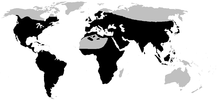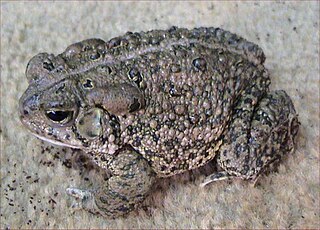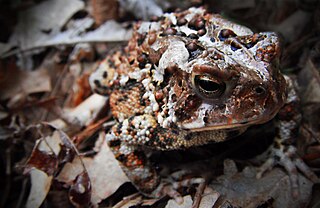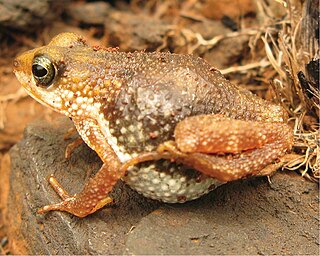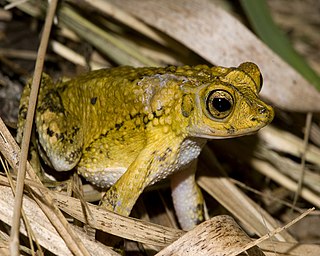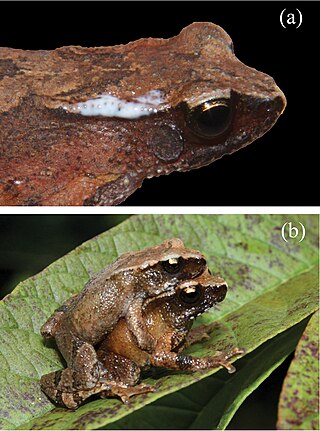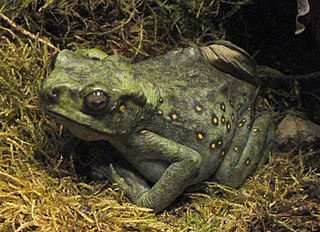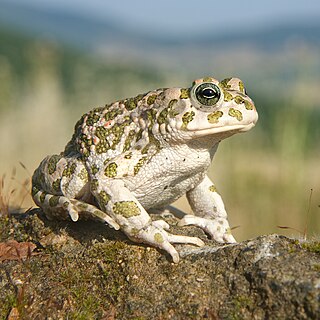| Genus name and author | Common name | Species |
|---|
|
| Adenomus Cope, 1861 | Dwarf toads | 2 |
| Altiphrynoides Dubois, 1987 | Ethiopian toads | 2 |
| Amazophrynella Fouquet et al., 2012 | | 12 |
| Anaxyrus Tschudi, 1845 | | 23 |
| Ansonia Stoliczka, 1870 | Stream toads | 34 |
| Atelopus Duméril & Bibron, 1841 | Stubfoot toads | 96 |
| Barbarophryne Beukema, de Pous, Donaire-Barroso, Bogaerts, Garcia-Porta, Escoriza, Arribas, El Mouden, and Carranza, 2013 (1 sp.) | Tiznit toad; Brongersma's toad | 1 |
| Blythophryne Chandramouli et al., 2016 [13] | Andaman bush toads | 1 |
| Bufo Garsault, 1764 | Toads | 18 |
| Bufoides Pillai & Yazdani, 1973 | Mawblang toads; Rock toads | 2 |
| Bufotes Rafinesque, 1815 | Palearctic green toads | 15 |
| Capensibufo Grandison, 1980 | Cape toads | 5 |
| Churamiti Channing & Stanley, 2002 | | 1 |
| Dendrophryniscus Jiménez de la Espada, 1871 | Tree toads | 16 |
| Didynamipus Andersson, 1903 | Four-digit toad | 1 |
| Duttaphrynus Frost et al., 2006 | Dutta's toads | 23 |
| Epidalea Cope, 1864 | Natterjack toad | 1 |
| Firouzophrynus Safaei-Mahroo and Ghaffari, 2020 | Firouz's toads | 5 |
| Frostius Cannatella, 1986 | Frost's toads | 2 |
| Ghatophryne Biju, Van Bocxlaer, Giri, Loader, and Bossuyt, 2009 | | 2 |
| Incilius Cope, 1863 | Central American toads; Middle American toads; Cerro Utyum toads | 39 |
| Ingerophrynus Frost, Grant, Faivovich, Bain, Haas, Haddad, de Sá, Channing, Wilkinson, Donnellan, Raxworthy, Campbell, Blotto, Moler, Drewes, Nussbaum, Lynch, Green, and Wheeler, 2006 | Hainan toads | 12 |
| Laurentophryne Tihen, 1960 | Parker's tree toad | 1 |
| Leptophryne Fitzinger, 1843 | Indonesia tree toads | 3 |
| Melanophryniscus Gallardo, 1961 | South American redbelly toads | 29 |
| Mertensophryne Tihen, 1960 | Snouted frogs | 14 |
| Metaphryniscus Señaris, Ayarzagüena & Gorzula, 1994 | | 1 |
| Nannophryne Günther, 1870 | | 4 |
| Nectophryne Buchholz & Peters, 1875 | African tree toads | 2 |
| Nectophrynoides Buchholz & Peters, 1875 | African live-bearing toads | 13 |
| Nimbaphrynoides Dubois, 1987 | Nimba toads | 1 |
| Oreophrynella Boulenger, 1895 | Bush toads | 8 |
| Osornophryne Ruiz-Carranza & Hernández-Camacho, 1976 | Plump toads | 11 |
| Parapelophryne Fei, Ye & Jiang, 2003 | | 1 |
| Pedostibes Günther, 1876 | Asian tree toads | 1 |
| Pelophryne Barbour, 1938 | Flathead toads | 13 |
| Peltophryne Fitzinger, 1843 | Caribbean toads | 14 |
| Phrynoidis Fitzinger in Treitschke, 1842 | Rough toads | 2 |
| Poyntonophrynus Frost, Grant, Faivovich, Bain, Haas, Haddad, de Sá, Channing, Wilkinson, Donnellan, Raxworthy, Campbell, Blotto, Moler, Drewes, Nussbaum, Lynch, Green, and Wheeler, 2006 | Pygmy toads | 11 |
| Pseudobufo Tschudi, 1838 | False toad | 1 |
| Rentapia Chan, Grismer, Zachariah, Brown, and Abraham, 2016 | | 2 |
| Rhaebo Cope, 1862 | Cope toads | 13 |
| Rhinella Fitzinger, 1826 | Beaked toads | 94 |
| Sabahphrynus Matsui, Yambun, and Sudin, 2007 | Sabah earless toad | 1 |
| Schismaderma Smith, 1849 | African split-skin toad | 1 |
| Sclerophrys Tschudi, 1838 | | 44 |
| Sigalegalephrynus Smart, Sarker, Arifin, Harvey, Sidik, Hamidy, Kurniawan, and Smith, 2017 | Puppet toads | 5 |
| Strauchbufo Fei, Ye, and Jiang, 2012 | Siberian toad; Mongolian toad | 1 |
| Truebella Graybeal & Cannatella, 1995 | | 2 |
| Vandijkophrynus Frost, Grant, Faivovich, Bain, Haas, Haddad, de Sá, Channing, Wilkinson, Donnellan, Raxworthy, Campbell, Blotto, Moler, Drewes, Nussbaum, Lynch, Green, and Wheeler, 2006 | Van Dijk's toads | 6 |
| Werneria Poche, 1903 | Smalltongue toads | 6 |
| Wolterstorffina Mertens, 1939 | Wolterstorff toads | 3 |
| Xanthophryne Biju, Van Bocxlaer, Giri, Loader & Bossuyt, 2009 | | 2 |
|

